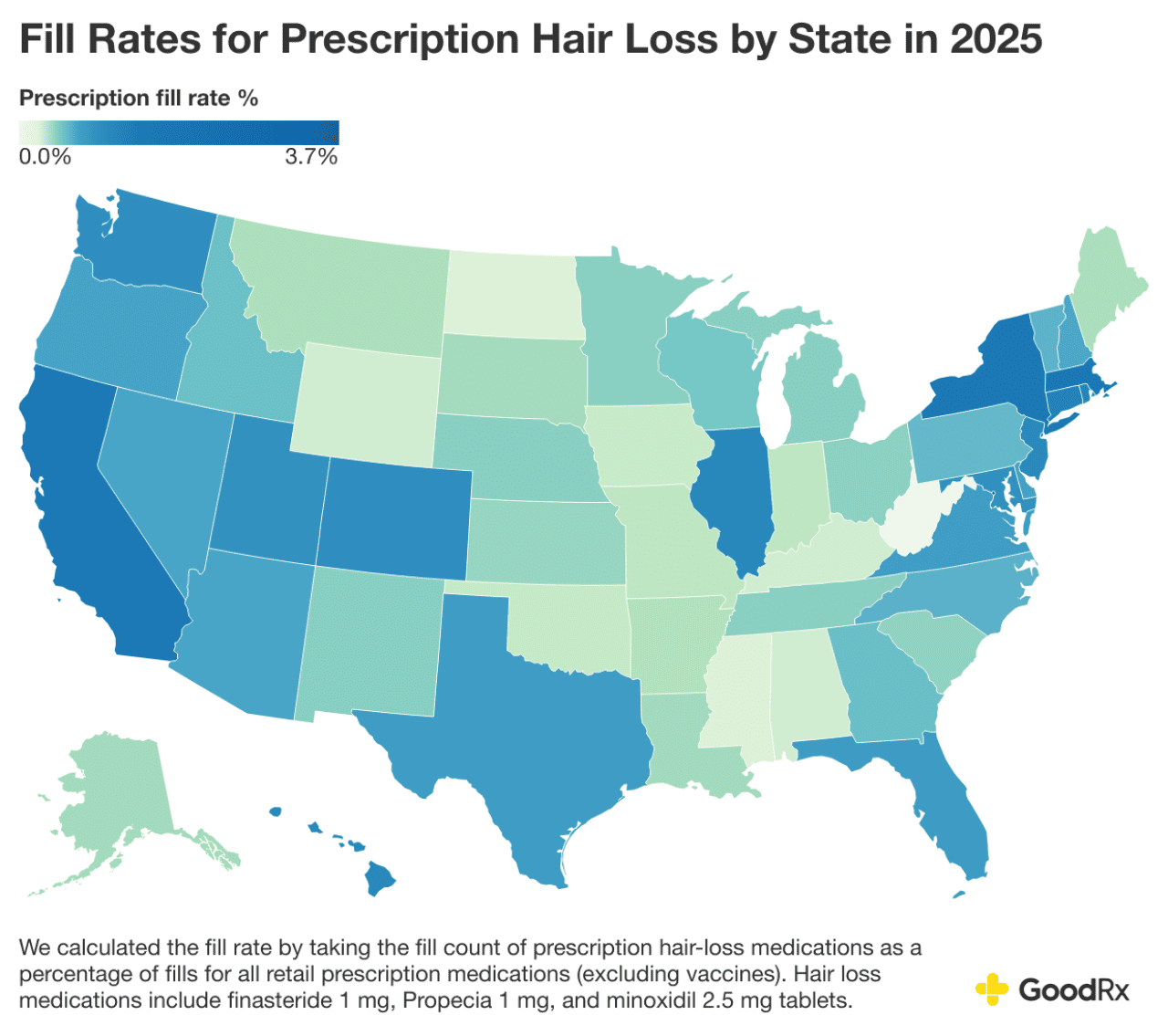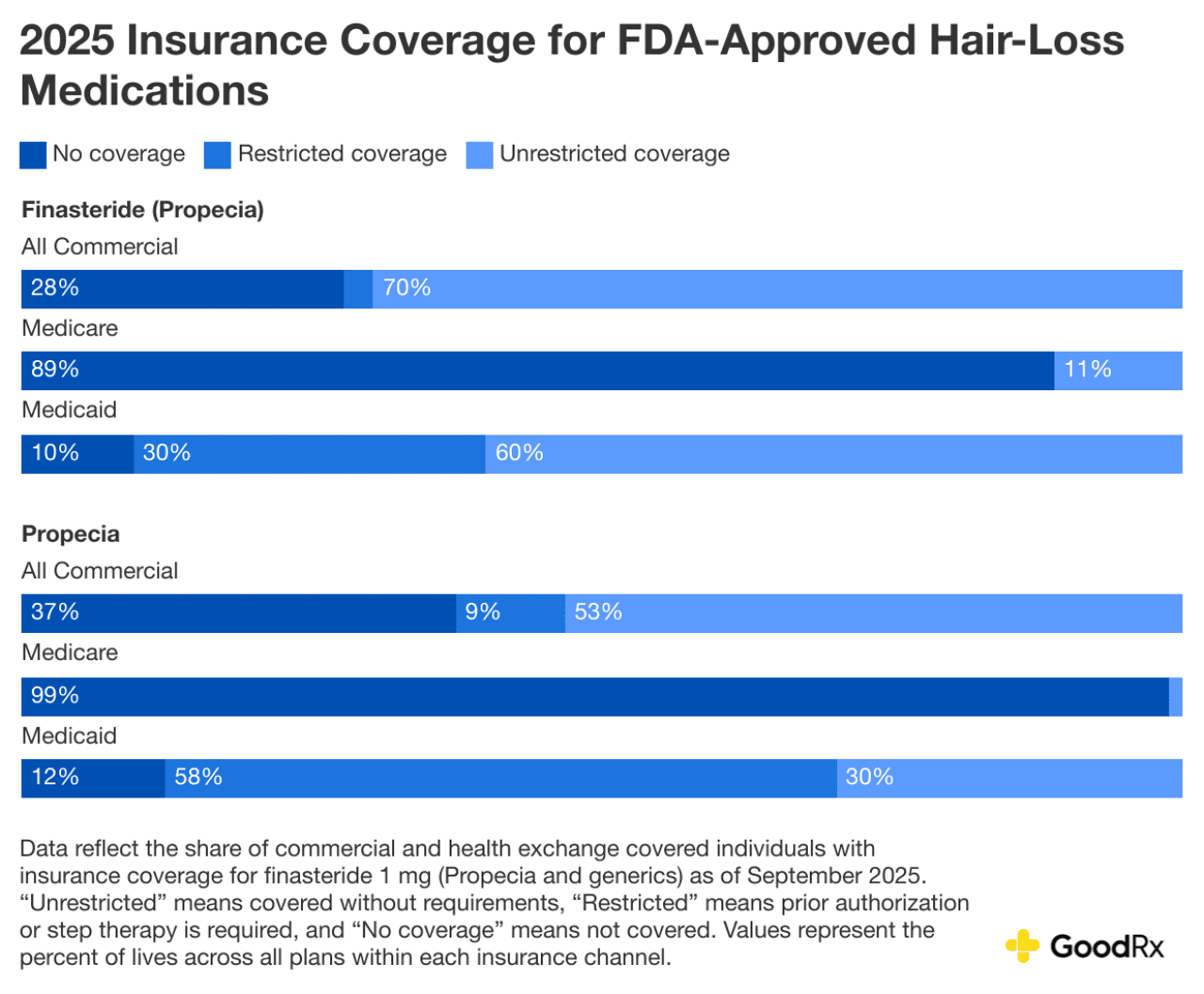Baldest states: New data on where men fill hair-loss medication prescriptions the most
Lifestyle

Audio By Carbonatix
12:50 PM on Wednesday, October 29
By Tori Marsh for GoodRx, Stacker
Baldest states: New data on where men fill hair-loss medication prescriptions the most
Many people in the U.S. are familiar with hair loss. About 30% to 50% of men will experience male-pattern baldness, or androgenetic alopecia, by the age of 50. The condition is characterized by thinning, loosening, and loss of hair, typically on the head. But, as it turns out, men in some states are treating hair loss more than average.
New research from GoodRx, a platform for medication savings, shows that the pursuit of fuller hair varies dramatically by geography and health insurance.
To be sure, the geographic disparity in fill rates isn’t due to genetics. Male-pattern baldness is common across the U.S., but the willingness to treat it depends on money, access, and social acceptance of hair loss and baldness.
Key takeaways:
- Hair loss is common — around 30% to 50% of men will experience male-pattern baldness by age 50. Yet treatment isn’t universal, and prescriptions to treat it vary widely across the U.S.
- Washington D.C., leads the country, filling hair-loss prescriptions at more than five times the national average, followed by Massachusetts, New York, and California.
- West Virginia sits at the bottom, with fill rates at just one-quarter of the national average, with Mississippi and North Dakota also among the lowest.

The places most likely to treat baldness
The nation’s capital takes the crown. In the District of Columbia, 3.7% of all prescriptions for men ages 18 to 44 are for hair-loss drugs. That is five times more than the national average (0.7%).
Other standout states where a significant percentage of prescriptions are filled include:
- Massachusetts (1.6%)
- New York (1.5%)
- California (1.4%)
- Connecticut (1.2%)
Together, these states and cities highlight a pattern: The states with the highest fill rates for prescription hair-loss medications tend to have a higher average income. They are also home to urban centers where professional polish may be of extra importance.
Where baldness goes untreated
At the other end of the spectrum, prescriptions for hair loss are less common in parts of the South and Midwest. These states account for the smallest percentage of prescriptions for hair loss:
- West Virginia (0.18%)
- Mississippi (0.24%)
- North Dakota (0.24%)
- Wyoming (0.27%)
- Alabama (0.28%)
The insurance divide
Even when someone wants to treat hair loss, their insurance plan will shape whether it’s within reach. Finasteride and Propecia are both FDA approved for male-pattern hair loss, but coverage can be spotty:
- Commercial insurance: About 70% of members with commercial plans have unrestricted coverage for generic finasteride, but more than a quarter lack coverage entirely. For brand-name Propecia, access is much tighter — only about half of commercially insured individuals have unrestricted coverage, and more than a third have no coverage.
- Medicare: Coverage is virtually nonexistent. Nearly 90% of Medicare beneficiaries lack coverage for generic finasteride, and almost 99% lack coverage for Propecia. That’s because Medicare coverage explicitly excludes medications for cosmetic purposes or hair growth.
- Medicaid: Access is somewhat better than Medicaid but still limited. About 60% of Medicaid members have unrestricted coverage for generic finasteride, though many face restrictions. For Propecia, fewer than 30% have unrestricted coverage, and nearly 60% fall into restricted plans.
Meanwhile, oral minoxidil is only FDA approved to treat high blood pressure. It is prescribed off-label to treat hair loss, which means that insurance may not cover oral minoxidil for hair loss.

What is male-pattern hair loss?
Over 50 million men in the U.S. are diagnosed with androgenetic alopecia. It’s a genetic condition in which hair follicles react strongly to androgen hormones. Classic male-pattern hair loss is usually diagnosed by how the hair-loss pattern looks.
Other health conditions can also cause thinning hair or hair loss. Blood testing or a skin biopsy can be done to diagnose the exact cause of the hair loss.
Male-pattern baldness can start as early as puberty, and it becomes more common and the percent of men diagnosed increases with age. Hair loss is also common in women, particularly after menopause. It’s more prevalent and severe among white males, followed by Asian American males and African American males. Hair loss is also common in women, particularly after menopause.
Studies have shown that males with androgenetic alopecia are at an increased risk of cardiovascular heart disease, diabetes, and possibly prostate cancer. Some may also experience anxiety and depression. This seems especially true if they began to lose their hair at an early age, have extensive hair loss, or feel their balding is getting worse.
Treatments for hair loss
Medications used to treat male-pattern hair loss include:
- Minoxidil is a topical drug applied directly to the scalp to stimulate hair growth and slow down hair loss.
- Finasteride is an oral medication that slows hair loss by inhibiting the binding of a testosterone byproduct to hair follicle receptors.
- Dutasteride works similarly to finasteride. Some research suggests that dutasteride for hair loss is more effective than minoxidil and finasteride. The FDA has not approved it as a treatment of male-pattern hair loss, though it can be prescribed off-label for this purpose.
Researchers are also studying other hair-loss treatments, including:
- Platelet-rich plasma (PRP) injections: Your blood is drawn and a platelet-rich sample is separated out to be used to inject into the scalp where hair loss is occurring.
- Hair transplants: Plugs of hair are taken where hair is growing and transplanted to areas of hair loss.
- Microneedling: Microneedling can stimulate stem cells in the hair follicle and promote growth. This is often combined with other treatments, including PRP and minoxidil.
Methodology
GoodRx calculated the fill rate as the proportion of all paid prescription claims for hair-loss medications — finasteride 1 mg (brand Propecia and generics) and oral minoxidil 2.5 mg — among men ages 18 to 44. Topical minoxidil was excluded because it is available over the counter and is not consistently captured in prescription claims data. State-level fill rates were standardized by dividing each state’s rate by the corresponding national rate for the study period. Total male population counts for ages 20 to 44 were derived from the 2022 American Community Survey (ACS) 5-year state-level estimates (Table S0101). Claims data were obtained from a nationally representative dataset and restricted to fills between August 31, 2024, and September 2, 2025. Analyses were conducted at the state level, and the fill index for each state was defined as the ratio of the state’s average fill rate to the national average.
Formulary coverage data were sourced from Managed Markets Insight and Technology, LLC™ (MMIT) and are valid as of September 2025. These data represent the average share of covered lives across all available forms and dosages of each medication. Estimates are reported separately for Medicare and Medicaid, and for commercial channels, which include both commercial and health exchange plans (collectively referred to as “All Commercial”). Coverage is classified into three categories: unrestricted coverage, where the drug is covered without additional requirements; restricted coverage, where prior authorization or step therapy is required; and no coverage, where the drug is not covered by insurance. Reported values reflect the percentage of lives in all plans within each insurance channel.
This story was produced by GoodRx and reviewed and distributed by Stacker.
